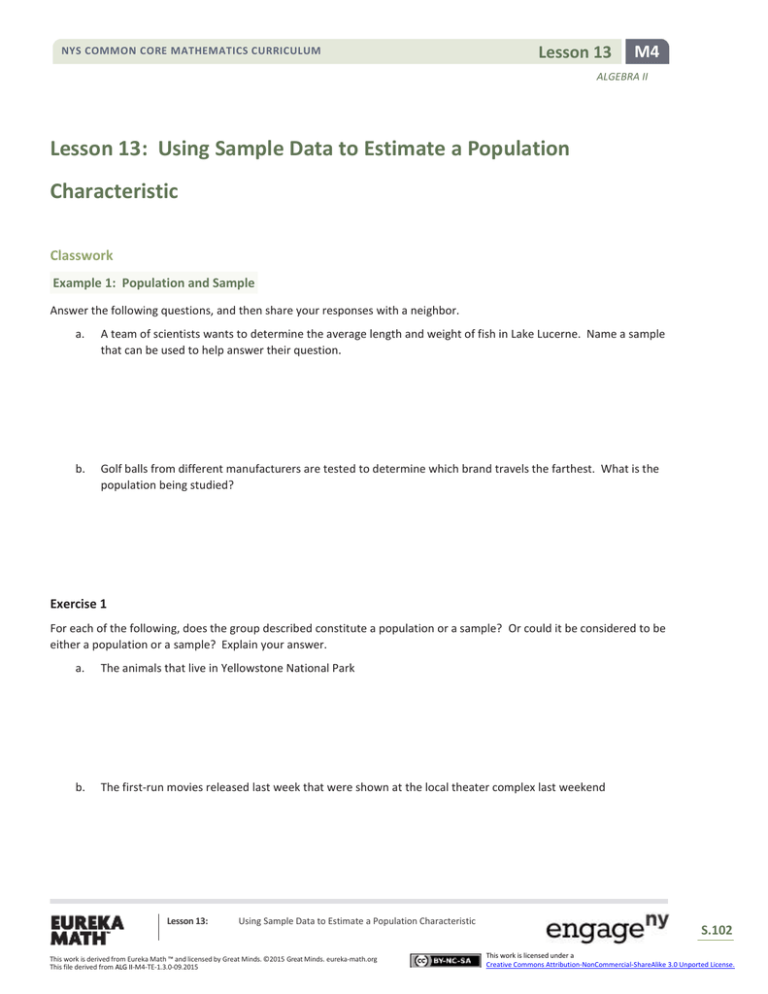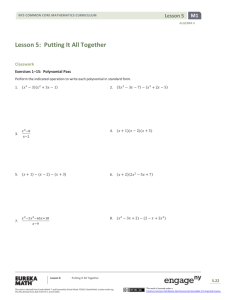Algebra II Module 4, Topic C, Lesson 13: Student Version
advertisement

NYS COMMON CORE MATHEMATICS CURRICULUM Lesson 13 M4 ALGEBRA II Lesson 13: Using Sample Data to Estimate a Population Characteristic Classwork Example 1: Population and Sample Answer the following questions, and then share your responses with a neighbor. a. A team of scientists wants to determine the average length and weight of fish in Lake Lucerne. Name a sample that can be used to help answer their question. b. Golf balls from different manufacturers are tested to determine which brand travels the farthest. What is the population being studied? Exercise 1 For each of the following, does the group described constitute a population or a sample? Or could it be considered to be either a population or a sample? Explain your answer. a. The animals that live in Yellowstone National Park b. The first-run movies released last week that were shown at the local theater complex last weekend Lesson 13: Using Sample Data to Estimate a Population Characteristic This work is derived from Eureka Math ™ and licensed by Great Minds. ©2015 Great Minds. eureka-math.org This file derived from ALG II-M4-TE-1.3.0-09.2015 S.102 This work is licensed under a Creative Commons Attribution-NonCommercial-ShareAlike 3.0 Unported License. Lesson 13 NYS COMMON CORE MATHEMATICS CURRICULUM M4 ALGEBRA II c. People who are asked how they voted in an exit poll d. Some cars on the lot of the local car dealer e. The words of the Gettysburg Address f. The colors of pencils available in a 36-count packet of colored pencils g. The students from your school who attended your school’s soccer game yesterday Example 2: Representative Sample If a sample is taken for the purpose of generalizing to a population, the sample must be representative of the population. In other words, it must be similar to the population even though it is smaller than the population. For example, suppose you are the campaign manager for your friend who is running for senior class president. You would like to know what proportion of students would vote for her if the election was held today. The class is too big to ask everyone (314 students). What would you do? Comment on whether or not each of the following sampling procedures should be used. Explain why or why not. a. Poll everyone in your friend’s math class. Lesson 13: Using Sample Data to Estimate a Population Characteristic This work is derived from Eureka Math ™ and licensed by Great Minds. ©2015 Great Minds. eureka-math.org This file derived from ALG II-M4-TE-1.3.0-09.2015 S.103 This work is licensed under a Creative Commons Attribution-NonCommercial-ShareAlike 3.0 Unported License. Lesson 13 NYS COMMON CORE MATHEMATICS CURRICULUM M4 ALGEBRA II b. Assign every student in the senior class a number from 1 to 314. Then, use a random number generator to select 30 students to poll. c. Ask every student who is going through the lunch line in the cafeteria who they will vote for. Exercise 2 There is no procedure that guarantees a representative sample. But the best procedure to obtain a representative sample is one that gives every different possible sample an equal chance to be chosen. The sample resulting from such a procedure is called a random sample. Suppose that you want to randomly select 60 employees from a group of 625 employees. Explain how to use a random number table or a calculator with a random number generator to choose 60 different numbers at random and include the students with these numbers in the sample. Lesson 13: Using Sample Data to Estimate a Population Characteristic This work is derived from Eureka Math ™ and licensed by Great Minds. ©2015 Great Minds. eureka-math.org This file derived from ALG II-M4-TE-1.3.0-09.2015 S.104 This work is licensed under a Creative Commons Attribution-NonCommercial-ShareAlike 3.0 Unported License. Lesson 13 NYS COMMON CORE MATHEMATICS CURRICULUM M4 ALGEBRA II Example 3: Population Characteristics and Sample Statistics A statistical study begins with a question of interest that can be answered by data. Depending on the study, data could be collected from all individuals in the population or from a random sample of individuals selected from the population. Read through the following, and identify which of the summary measures represents a population characteristic and which represents a sample statistic. Explain your reasoning for each. Suppose the population of interest is the words of the Gettysburg Address. There are 269 of them (depending on the version). a. The proportion of nouns in all words of the Gettysburg Address b. The proportion of nouns or the proportion of words containing the letter e in a random sample of words taken from the Gettysburg Address c. The mean length of the words in a random sample of words taken from the Gettysburg Address d. The proportion of all words in the Gettysburg Address that contain the letter e e. The mean length of all words in the Gettysburg Address Lesson 13: Using Sample Data to Estimate a Population Characteristic This work is derived from Eureka Math ™ and licensed by Great Minds. ©2015 Great Minds. eureka-math.org This file derived from ALG II-M4-TE-1.3.0-09.2015 S.105 This work is licensed under a Creative Commons Attribution-NonCommercial-ShareAlike 3.0 Unported License. NYS COMMON CORE MATHEMATICS CURRICULUM Lesson 13 M4 ALGEBRA II Exercise 3 For the following items of interest, describe an appropriate population, population characteristic, sample, and sample statistic. Explain your answer. a. Time it takes students to run a quarter mile b. National forests that contain bald eagle nests c. Curfew time of boys compared to girls d. Efficiency of electric cars Lesson 13: Using Sample Data to Estimate a Population Characteristic This work is derived from Eureka Math ™ and licensed by Great Minds. ©2015 Great Minds. eureka-math.org This file derived from ALG II-M4-TE-1.3.0-09.2015 S.106 This work is licensed under a Creative Commons Attribution-NonCommercial-ShareAlike 3.0 Unported License. Lesson 13 NYS COMMON CORE MATHEMATICS CURRICULUM M4 ALGEBRA II Exercise 4 Consider the following questions: What proportion of eleventh graders at our high school are taking at least one advanced placement course? What proportion of eleventh graders at our high school have a part-time job? What is the typical number of hours an eleventh grader at our high school studies outside of school hours on a weekday (Monday, Tuesday, Wednesday, or Thursday)? What is the typical time (in minutes) that students at our high school spend getting to school? What is the proportion of students at our high school who plan to attend a college or technical school after graduation? What is the typical amount of time (in hours per week) that students at our high school are involved in community service? Select one of these questions (or a different statistical question that has been approved by your teacher). Working with your group, write a paragraph that: States the statistical question of interest pertaining to the students in the population for the statistical question selected. Identifies a population characteristic of interest. Identifies the appropriate statistic based on a sample of 40 students. States what property your sample must have for you to be able to use its results to generalize to all students in your high school. Includes the details on how you would select your sample. Lesson 13: Using Sample Data to Estimate a Population Characteristic This work is derived from Eureka Math ™ and licensed by Great Minds. ©2015 Great Minds. eureka-math.org This file derived from ALG II-M4-TE-1.3.0-09.2015 S.107 This work is licensed under a Creative Commons Attribution-NonCommercial-ShareAlike 3.0 Unported License. Lesson 13 NYS COMMON CORE MATHEMATICS CURRICULUM M4 ALGEBRA II Lesson Summary We refer to summary measures calculated using data from an entire population as population characteristics. We refer to summary measures calculated using data from a sample as sample statistics. To generalize from a sample to the corresponding population, it is important that the sample be a random sample from the population. A random sample is one that is selected in a way that gives every different possible sample an equal chance of being chosen. Problem Set 1. 2. 3. In the following, identify whether the subjects being measured are the sample or the population. In some cases, they could be considered a sample or a population. Explain each answer. Subjects What Is Being Measured Some students in your class Number of books in backpack AA batteries of a certain brand Lifetime Birds in Glacier National Park Number of species Students in your school Number absent or present today Words in the Constitution of the U.S. Whether a noun or not Americans of voting age Opinion on an issue Sample or Population? Explain For the following items of interest, describe an appropriate population, a population characteristic, a sample, and a sample statistic: a. Whether or not a driver is speeding in your school zone during school hours in a day b. Seatbelt usage of men compared to women c. Impact of a new antidepressant on people with severe headaches What are the identification numbers for ten students chosen at random from a population of 78 students based on the following string of random digits? Start at the left. 27816 78416 01822 73521 37741 016312 68000 53645 56644 97892 63408 77919 44575 Lesson 13: Using Sample Data to Estimate a Population Characteristic This work is derived from Eureka Math ™ and licensed by Great Minds. ©2015 Great Minds. eureka-math.org This file derived from ALG II-M4-TE-1.3.0-09.2015 S.108 This work is licensed under a Creative Commons Attribution-NonCommercial-ShareAlike 3.0 Unported License.









